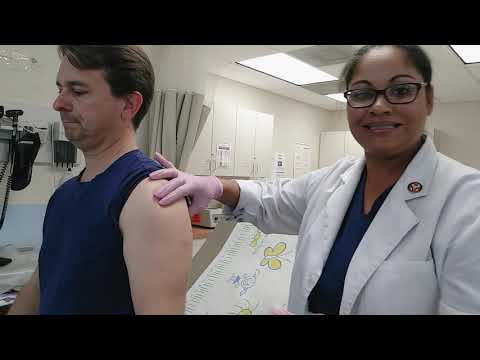What You Need to Know about Giving Shots as a Medical Assistant
Contents
- What are shots?
- What types of shots are there?
- Who can give shots?
- How do you give a shot?
- What are the side effects of shots?
- How do you handle a difficult shot?
- What are some tips for giving shots?
- What should you do after a shot is given?
- What are the risks of giving shots?
- What are the benefits of giving shots?
As a medical assistant you may be called upon to give shots to patients. It’s important to know how to do this properly, and this blog post will tell you everything you need to know.
Checkout this video:
What are shots?
Shots are a type of immunization that help protect people from diseases. They work by injecting a person with a small amount of a virus or bacteria that has been weakened so it can’t cause disease. The body then produces immunity, or resistance, to that particular disease.
What types of shots are there?
There are many types of shots that Medical assistants may be responsible for administering. These can include vaccines, such as the flu shot, as well as other types of injections, such as those for allergies or other medications. It’s important to be aware of the different types of shots so that you can be prepared to administer them properly.
Vaccines are typically given through intramuscular (IM) injections, which means that the needle is inserted into the muscle. The most common IM injection sites are the arm, leg, and buttocks. Allergy shots and other types of IM injections are also typically given in these same sites.
Intradermal (ID) injections are another type of shot that Medical Assistants may be responsible for administering. These shots are given into the skin, and the most common site for ID injections is the forearm. The needle for an ID injection is inserted at a shallow angle so that it does not reach the muscle underneath the skin.
Subcutaneous (SC) injections are given under the skin and are usually done in areas with a lot of fatty tissue, such as the thighs, hips, or upper arms. SC injections do not go into muscle like IM injections do; instead, they go into the layer of fat between the skin and muscle.
Giving shots may not be the most glamorous part of being a medical assistant but it’s an important responsibility nonetheless. With a little practice and knowledge about the different types of shots, you can feel confident in your ability to administer them properly.
Who can give shots?
As a medical assistant you may be called upon to give shots to patients from time to time. It’s important to know that not all medical assistants are certified to give injections, and even those who are certified may not be comfortable doing so. If you are comfortable giving shots and are certified to do so, there are a few things you should keep in mind.
First, make sure you know the patient’s medical history. There are some conditions that may make it unsafe for a patient to receive a shot. For example, if a patient has a bleeding disorder or is taking blood thinners, they may be at risk for excessive bleeding if they receive a shot.
Second, make sure you know how to properly prepare the injection site. The injection site should be clean and free of any debris. You will also need to choose an injection site that is appropriate for the type of injection you are giving. For example, intramuscular injections should be given in the upper arm, while subcutaneous injections can be given in the thigh or abdomen.
Third, make sure you use sterile equipment. All needles and syringes should be sterile and disposed of properly after use.
Fourth, make sure you know how to properly administer the injection. Injections can be given intramuscularly (into the muscle), subcutaneously (under the skin), or intravenously (into the vein). The type of injection will determine how deep the needle needs to be inserted into the skin.
Giving shots may not be your favorite part of the job, but it is an important skill for medical assistants to have. With proper training and practice, you can become comfortable and confident in your ability to give injections safely and effectively.
How do you give a shot?
There are different types of shots that medical assistants may be required to give, including intramuscular (IM) injections and subcutaneous (SC) injections. Each type of injection is given using a different technique, so it’s important to know how to properly administer each type.
IM injections are given into the muscle, while SC injections are given just under the skin. To give an IM injection, the medical assistant will use a needle that is longer than the one used for an SC injection. The needle is inserted at a 90 degree angle and then injected into the muscle. To give an SC injection, the needle is inserted at a 45 degree angle and then injected into the fatty tissue just under the skin.
Both IM and SC injections can be given in the upper arm, thigh, or buttocks. When giving an injection in the upper arm, the medical assistant will aim for the space between the shoulder and elbow. When giving an injection in the thigh, the medical assistant will aim for the space between the hip and knee. When giving an injection in the buttocks, the medical assistant will aim for the upper outer quadrant of the buttock.
Before giving any injection, it’s important to cleanse the area with alcohol or another antiseptic solution. This helps to prevent infection. The medical assistant will then tie a tourniquet around the upper arm to help make veins more visible, if necessary. Once all of these steps have been completed, it’s time to give the shot!
What are the side effects of shots?
Most people experience only minor side effects from shots, such as redness, swelling, pain, or itching at the injection site. These usually go away quickly. Serious side effects are rare. They can include allergic reactions, such as hives, difficulty breathing, and swelling of the face, lips, or tongue. If you have a serious allergic reaction, seek medical help immediately. Other rare but serious side effects include fainting and seizures.
How do you handle a difficult shot?
As a medical assistant, you may be called upon to give shots to patients from time to time. This can be a difficult task, as some patients may be intimidated or nervous about receiving a shot. Here are some tips on how to handle a difficult shot:
– Explain the procedure to the patient beforehand, in order to help them understand what is going to happen.
– Make sure the patient is relaxed before administering the shot.
– Use a slow and steady technique when giving the shot.
– Have the patient breathe deeply and evenly during the procedure.
– Apply pressure to the injection site after the shot is given, in order to help reduce swelling.
What are some tips for giving shots?
-Wash your hands and put on gloves.
-Clean the injection site with an alcohol swab.
-Let the area air dry for 15 seconds.
-Pinch the skin at the injection site to form a “tent.”
– insert the needle at a 45 degree angle into the tent.
-As you insert the needle, pull back on the plunger. If you see blood, that means you have hit a blood vessel. Remove the needle and start again.
-Once the needle is in far enough, inject the medicine by slowly pushing down on the plunger.
-After you’ve injected all of the medicine, remove the needle and dispose of it in a sharps container.
-Apply pressure to the injection site with a cotton ball or gauze pad.
What should you do after a shot is given?
After a shot is given, there are several things that medical assistants must do in order to ensure the safety of the patient. First, it is important to apply pressure to the injection site for at least two minutes. This will help to prevent bleeding and bruising. Next, the area should be covered with a bandage or dressing. It is also important to dispose of any used needles and syringes in a puncture-proof container. Finally, it is essential to wash your hands thoroughly with soap and water.
What are the risks of giving shots?
There are a few risks associated with giving shots, but they are generally mild and can be easily avoided. The most common risk is the chance of bruising or bleeding at the injection site. This can usually be avoided by using a smaller needle or by massaging the area after the shot is given. There is also a very small risk of infection, but this can be avoided by using sterile techniques and disposable needles.
What are the benefits of giving shots?
Giving shots is an important part of the medical assistant’s job. It is a way to prevent and treat illness, and to promote wellness. Shots can be given to patients of all ages, and they are an important part of the medical assistant’s job. There are many benefits to giving shots, including:
-They are an effective way to prevent illness.
-They can be used to treat a variety of conditions.
-They are a safe and painless procedure.
-They are quick and easy to administer.
Giving shots is an important part of the medical assistant’s job, and there are many benefits to giving them.







